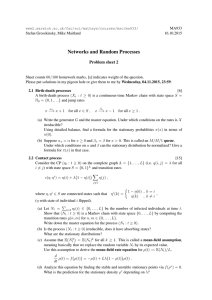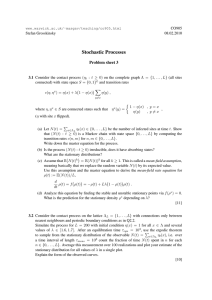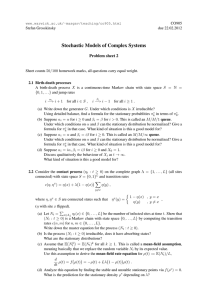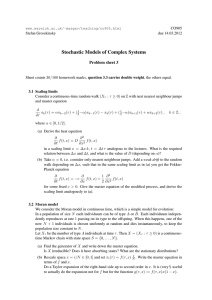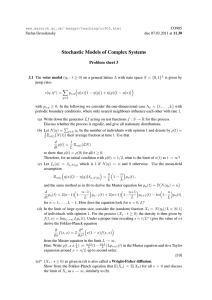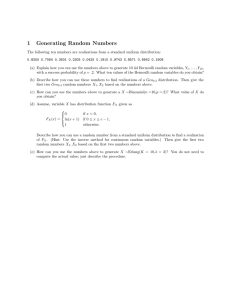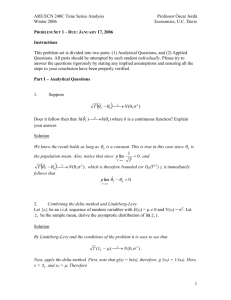Stochastic Models of Complex Systems Problem sheet 2
advertisement
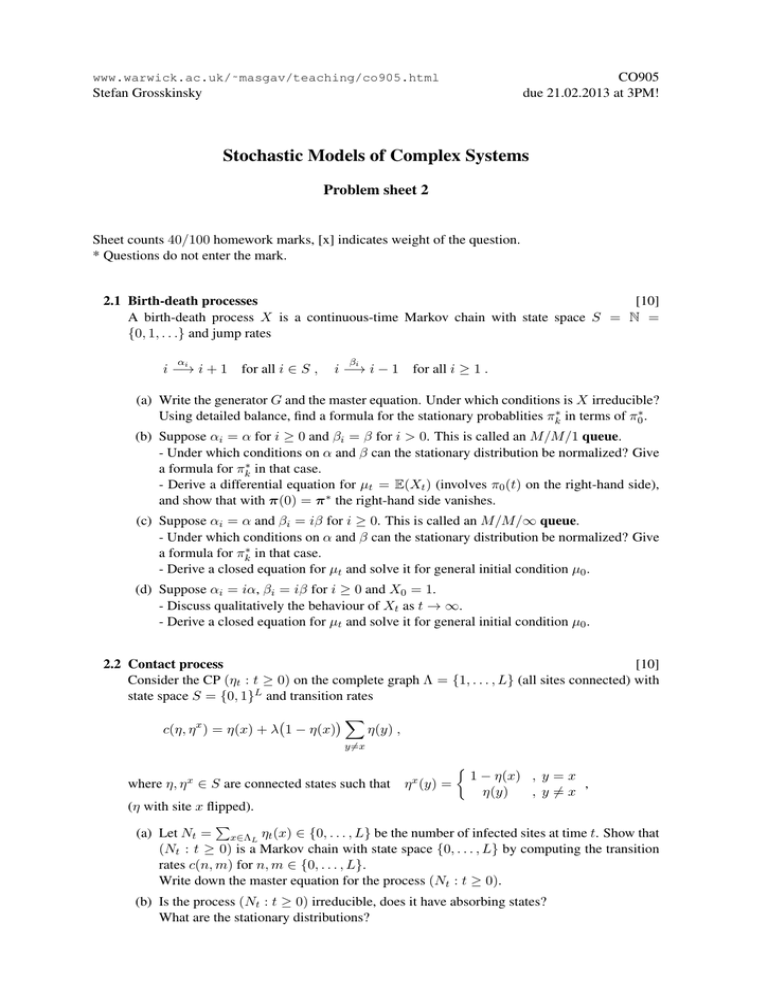
CO905
due 21.02.2013 at 3PM!
www.warwick.ac.uk/˜masgav/teaching/co905.html
Stefan Grosskinsky
Stochastic Models of Complex Systems
Problem sheet 2
Sheet counts 40/100 homework marks, [x] indicates weight of the question.
* Questions do not enter the mark.
2.1 Birth-death processes
[10]
A birth-death process X is a continuous-time Markov chain with state space S = N =
{0, 1, . . .} and jump rates
α
i
i −→
i+1
for all i ∈ S ,
βi
i −→ i − 1 for all i ≥ 1 .
(a) Write the generator G and the master equation. Under which conditions is X irreducible?
Using detailed balance, find a formula for the stationary probablities πk∗ in terms of π0∗ .
(b) Suppose αi = α for i ≥ 0 and βi = β for i > 0. This is called an M/M/1 queue.
- Under which conditions on α and β can the stationary distribution be normalized? Give
a formula for πk∗ in that case.
- Derive a differential equation for µt = E(Xt ) (involves π0 (t) on the right-hand side),
and show that with π(0) = π ∗ the right-hand side vanishes.
(c) Suppose αi = α and βi = iβ for i ≥ 0. This is called an M/M/∞ queue.
- Under which conditions on α and β can the stationary distribution be normalized? Give
a formula for πk∗ in that case.
- Derive a closed equation for µt and solve it for general initial condition µ0 .
(d) Suppose αi = iα, βi = iβ for i ≥ 0 and X0 = 1.
- Discuss qualitatively the behaviour of Xt as t → ∞.
- Derive a closed equation for µt and solve it for general initial condition µ0 .
2.2 Contact process
[10]
Consider the CP (ηt : t ≥ 0) on the complete graph Λ = {1, . . . , L} (all sites connected) with
state space S = {0, 1}L and transition rates
X
c(η, η x ) = η(x) + λ 1 − η(x)
η(y) ,
y6=x
where η, η x ∈ S are connected states such that η x (y) =
1 − η(x) , y = x
,
η(y)
, y 6= x
(η with site x flipped).
P
(a) Let Nt = x∈ΛL ηt (x) ∈ {0, . . . , L} be the number of infected sites at time t. Show that
(Nt : t ≥ 0) is a Markov chain with state space {0, . . . , L} by computing the transition
rates c(n, m) for n, m ∈ {0, . . . , L}.
Write down the master equation for the process (Nt : t ≥ 0).
(b) Is the process (Nt : t ≥ 0) irreducible, does it have absorbing states?
What are the stationary distributions?
(c) Assume that E Ntk = E(Nt )k for all k ≥ 1. This is called a mean-field assumption,
meaning basically that we replace the random variable Nt by its expected value.
Use this assumption to derive the mean-field rate equation for ρ(t) := E(Nt )/L,
d
ρ(t) = f ρ(t) = −ρ(t) + Lλ 1 − ρ(t) ρ(t) .
dt
(d) Analyze this equation by finding the stable and unstable stationary points via f (ρ∗ ) = 0.
What is the prediction for the stationary density ρ∗ depending on λ?
2.3 Simulation of CP
(Sample code on the course webpage)
[20]
Consider the contact process (ηt : t ≥ 0) as defined in Q2.2, but now on the one-dimensional
lattice ΛL = {1, . . . , L} with connections only between nearest neighbours and periodic boundary conditions.
The critical value λc is defined such that the infection on the infinite lattice Λ = Z started from
the fully infected lattice dies out for λ < λc , and survives for λ > λc . It is known numerically
up to several digits, depends on the dimension, and lies in the interval [1, 2] in our case.
All simulations of the process should be done with initial condition η0 (x) = 1 for all x ∈ Λ.
(a) To get a general idea, simulate the process for e.g. L =P256 for several values of
λ ∈ [1, 2]. Plot the number of infected individuals Nt =
x∈ΛL ηt (x) as a function
of time up to time 10 × L, averaging over 100 realizations in a double-logarithmic plot.
What is the expected behaviour of Nt depending on λ?
For a given system size L, find the window of interest choosing λ = 1, 1.2, . . . , 1.8, 2
averaging over 100 realizations with times up to 10 × L. Then use fine increments of
0.01 for λ and averages of at least 500 realizations to find an estimate of the critical value
λc (L) ∈ [1, 2].
Repeat this for different lattice sizes, e.g. L = 128, 256, 512, 1024, and plot your estimates of λc (L) against 1/L. Extrapolate to 1/L → 0 to get an estimate of λc = λc (∞).
This approach is called finite size scaling, in order to correct for systematic finite size
effects which influence the critical value.
(b) Let T be the hitting time of state η = 0, i.e. the lifetime of the infection. Measure the
lifetime of the infection for λ = 1 and λ = 2 by running the process until extinction of
the epidemic.
For λ = 1 < λc we expect T ∝ C log L+small fluctuations for some C > 0. So use
large system sizes e.g. L = 128, 256, 512, 1024 (or larger), confirm that E(T ) scales like
log L and determine C by averaging at least 200 realizations of T for each L. Then shift
your data Ti for each L by Ti − E(T ) and plot the ’empirical tail’ of the distribution of
the shifted data (use log-scale on the y-axis).
For λ = 2 > λc we expect T ∼ Exp(1/µ) to be an exponential random variable with
mean µ = E(T ) ∝ eCL for some C > 0. So use *small* system sizes e.g. L =
8, 10, 12, 14 (see how far you can go), confirm that E(T ) scales like eCL and determine
C by averaging at least 200 realizations of T . Then rescale your data Ti for each L by
Ti /E(T ) and plot the ’empirical tail’ of the distribution of the rescaled data (use log-scale
on the y-axis).
1 PM
The empirical tail of data T = (T1 , . . . , TM ) is the statistic tailt (T ) = M
i=1 1Ti >t .
This decays from 1 to 0 as a (random) function of time t.
BINNING DESTROYS INFORMATION → AVOID HISTOGRAMS!
(c)* Repeat the analysis of (a) on the fully connected graph ΛL , and compare your estimate of
λc with the mean-field prediction from Q2.2.
(d)* For λ = 0 and η0 (x) = 1 for all x ∈ Λ, derive a formula for the distribution of the lifetime
T of the infection. (Hint: google ’extreme value statistics’ and ’Gumbel distribution’.)
